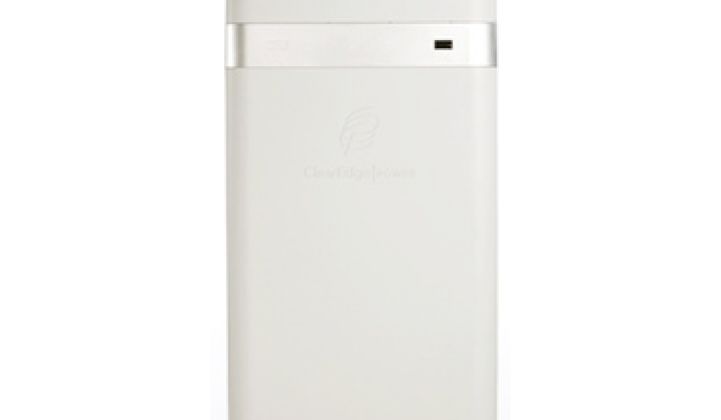ClearEdge Power plans to stick it where the sun doesn't shine.
The Hillsboro, Oregon-based company has just started to ship a 5-kilowatt fuel cell for large homes and small businesses in areas where the owners want to reduce carbon emissions and fuel consumption, but solar wouldn't be effective or economical. And with the price of natural gas in a lull, the geographic territory for these devices could potentially expand. ClearEdge's stationary fuel cell takes natural gas and runs it through a membrane to produce hydrogen, heat, water and carbon dioxide. The hydrogen then passes through a second membrane to produce electrons before delivering electric power and heat to the building.
While the fuel cell ultimately releases carbon dioxide, it is far more efficient – and thus less polluting – than consuming natural gas at home or burning natural gas at a power plant and delivering electricity down the wire. When consumers burn gas at home, they typically generate heat but not electricity. Burning it at power plants generates electricity, but also results in waste heat, which usually doesn't get converted into productive energy. Power also gets lost in transmission.
Because it can deliver heat and power, the fuel cell is around 90 percent efficient, said vice president of marketing Mike Upp.
"We don't burn gas. We chemically convert it," he said. "We are trying to fit in the places in the market where solar isn't an option."
Although fuel cells have been bandied about for years, the market now appears to be developing. After years of testing, Osaka Gas began offering a 1-kilowatt fuel cell from Panasonic to consumers in March. Like ClearEdge's system, it delivers heat and power. Bloom Energy, which has received $350 million in VC funds, has also signed contracts to deliver 25-kilowatt fuel cells to customers like eBay and reportedly continues to be on the verge of a broader commercial release. Any day now, really. Bloom's fuel cell is bigger, but Upp says that the technology – from the outside perspective – appears to be the same.
How does it compare to solar panels? ClearEdge's 5-kilowatt system sells for $50,000. California consumers, however, qualify for a $12,500 rebate which comes from a pool funded by ratepayers. That drops the price to $37,500, but there's more. Businesses qualify for a federal tax credit of $15,000 while homeowners can get a federal tax credit of $5,000. Proposals have been floated to raise the consumer credit to $15,000. With the higher tax credit, the cost of a fuel cell is roughly close to solar or even less, depending on the installer's quote.
California also passed a law, which goes into effect in January, that will allow fuel cell customers to sell power back to the grid. Consumers thus can run their fuel cell 24 hours a day to maximize efficiency.
Upp adds that fuel cells run constantly and aren't impacted by the weather. Further, natural gas prices are down, giving fuel cells an advantage over solar, he argues. With gas $1.50 a cubic foot, the system can produce power at 10 cents a kilowatt hour. Gas recently has dropped to $1.10. If you add in the amortized cost of the system, it can produce power at 10 cents a kilowatt hour when gas is at $1.10 a cubic foot and 13.5 cents at $1.50 gas.
"We use a half-a-therm an hour of natural gas," he added.
In a year, one system can generate 43.8 megawatt hours of electricity and 51 megawatt hours equivalent of heat. In PG&E territory, the payback takes about 3.5 years. Southern California Edison customers can achieve payback in five years. So far, most of ClearEdge's customers have come from Palm Springs, where consumers get socked with high power bills in the summer because of air conditioning costs. Burn gas to cool off – savor the irony.
It began shipping a few weeks ago. A few units have been installed and 300 have been sold. Later, ClearEdge will try to scale up the technology to produce 10-kilowatt units as well as smaller units.



